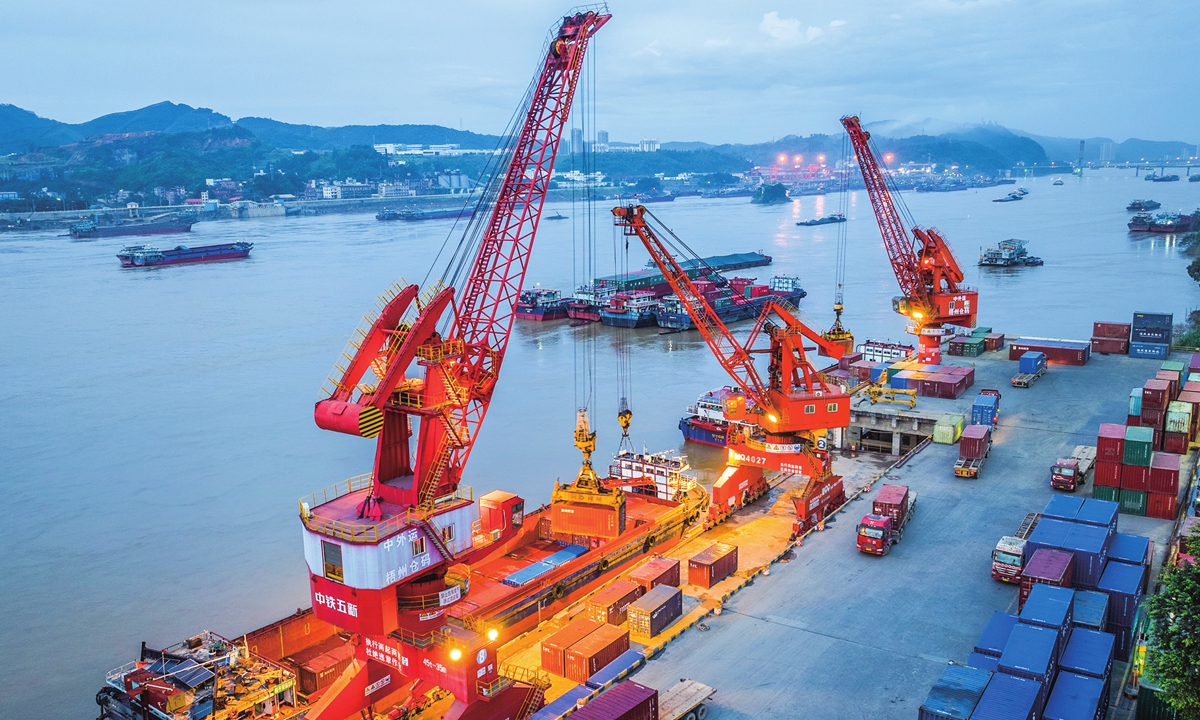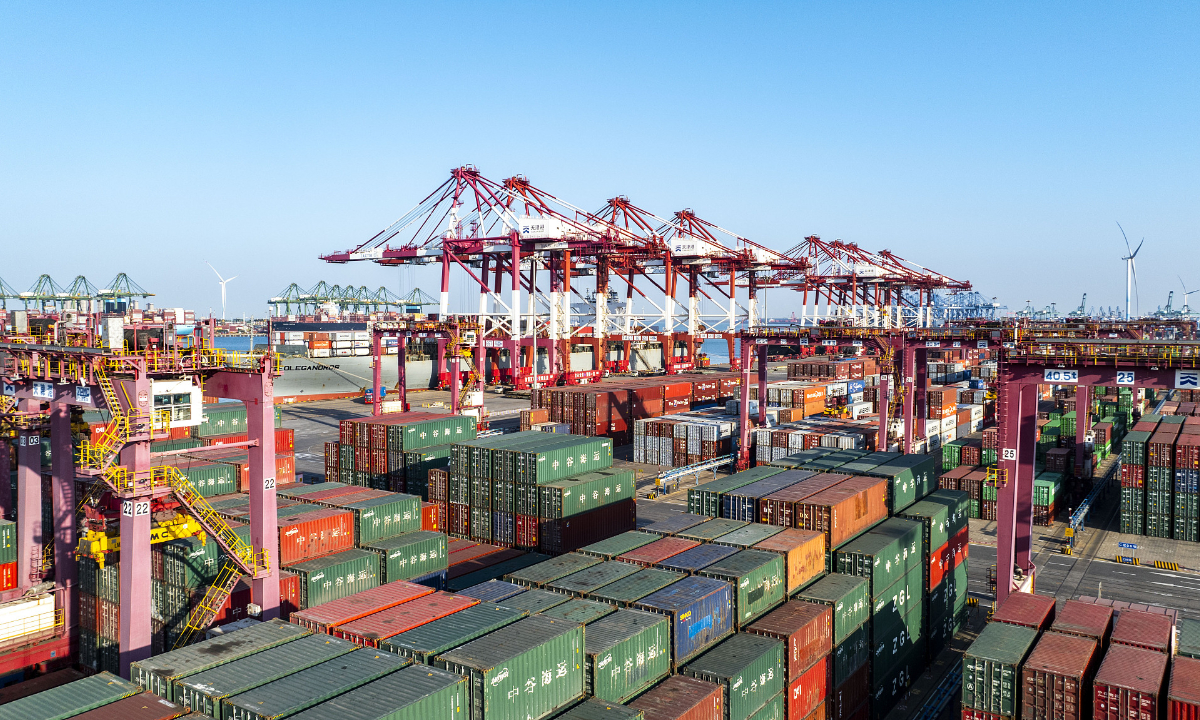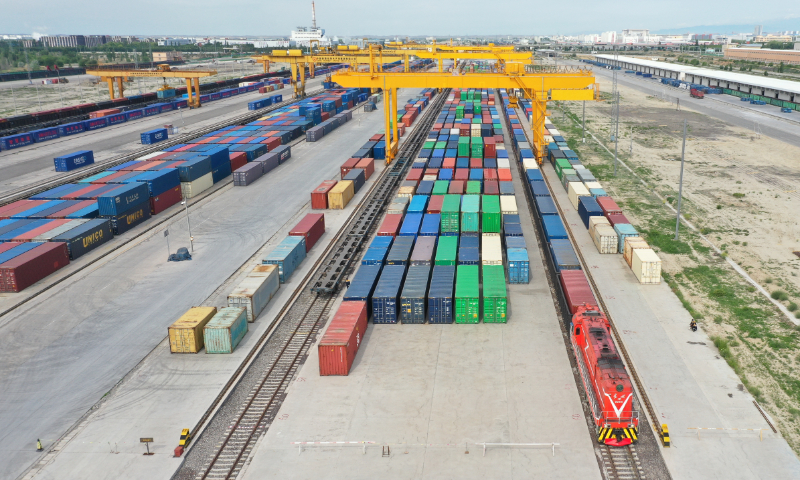Western media reports on China's H1 trade surplus politically-driven, lack economic logic: analyst

Trucks shuttle back and forth in a container terminal in Wuzhou, South China's Guangxi Zhuang Autonomous Region on June 26, 2024. China's foreign trade in the first half of the year recorded a yearly increase of 6.1 percent to reach21.17 trillion yuan, a record high amid the country's steady economic recovery. Photo: cnsphoto
Official data showed that China's exports of mechanical and electrical products, including cars, surged in the first half of 2024, and contributed to over half of China's total exports of goods, which analysts said underscored the nation's progress in high-end manufacturing and industrial transformation.
However, some Western media, such as Reuters, hyped that China's increase in exports, a year-on-year growth of 6.9 percent in the first half, suggested that "manufacturers are front-loading orders in anticipation of tariffs from a growing number of trade partners."
Concerning imports, foreign media reports continued to hype "the weakened consumption sector in China." Media including Bloomberg and Wall Street Journal specifically pointed out that China's imports in June dropped 0.6 percent year-on-year, pointing to "weak domestic demand."
When asked to comment on the Western media's attribution of the fall in June imports to weak domestic demand, Li Yong, a senior research fellow at the China Association of International Trade, said that such attribution is not scrupulous, and somewhat misleadingly generalized. What would the Western media say when China's imports in May increased by 5.2 percent and in Jan-May increased by 6.4 percent year-on-year? Why didn't Western media say it was the result of strong demand?
"The drop in June import is not an indication of weakening domestic demand," Li told the Global Times on Friday.
It is only seasonal, and one month's worth of data does not point to the weakening health of the economy. Even with the June drop, the total imports for the first half of the year registered an increase of 5.2 percent, Li noted. "Isn't it odd that Western media ignored that part of the trade performance and focused on interpreting the cause of June number missing expectations?"
Western media's reading on China's economic data is politically-driven and aims to satisfy the West's need to distort China's economic development and discredit China. Foreign media's interpretation of China's trade growth figures is unprofessional, unscientific, and biased, Li stressed.
"As a result of industrial upgrading and transformation, Chinese enterprises can now produce some of the intermediate goods, which they used to rely on imports, by themselves or by domestic manufacturers," said Zhu.
Intermediate goods are used to produce other goods and services in the production process, including raw materials, parts and semi-finished products.
Regarding exports, Zhu said that judging from experience, foreign tariffs have little impact on overall export performance.
At present, China's foreign trade enterprises are actively carrying out high-quality development, and exporting high-value-added products with scientific and technological content and patents, Zhu noted.
"Western media's argument about tariffs is an interpretation of trade behavior in the last month or two based on current market sentiment, which distorts trade facts," Li noted.
From January to June this year, China exported 7.14 trillion yuan ($980 billion) of mechanical and electrical products, up 8.2 percent year-on-year, whose value accounted for 58.9 percent of the nation's overall export volume during the period, China's General Administration of Customs (GAC) said on Friday.
Specifically, the export value of ships saw an increase of 91.1 percent year-on-year to reach 76.82 billion yuan. The value of vehicle exports reached 391.76 billion yuan, up by 22.2 percent year-on-year, and the export value of integrated circuits reached 542.74 billion yuan, an increase of 25.6 percent year-on-year.
"Our company and other foreign trade companies above the designated size (enterprises with annual business revenue over 20 million yuan) have witnessed stable growth in imports and exports of goods in the first half of the year," said Zhu.
Zhu noted that there are necessarily major differences among different categories. Goods of high value-added perform better in exports than low value-added products.
"China's goods export structure is in the process of shifting from traditional products to new products, such as the 'new three' products - new-energy vehicles (NEVs), lithium batteries, and photovoltaic products," Ma Jihua, a veteran economic observer, told the Global Times on Friday, attributing the growth to the nation's foreign trade structure optimization and upgrade.
"The structural adjustment of China's export goods aligns with the trade needs of major trading partners. From the perspective of high-tech products, the US and some other Western countries have politicized high-tech products," said Li.
More exports of high-value-added goods fueled China's exports in the first half of 2024, which totaled 12.13 trillion yuan, up 6.9 percent year-on-year. Imports totaled 9.04 trillion yuan, up 5.2 percent. According to GAC data, total foreign trade topped 21.17 trillion yuan, reaching a new high.



